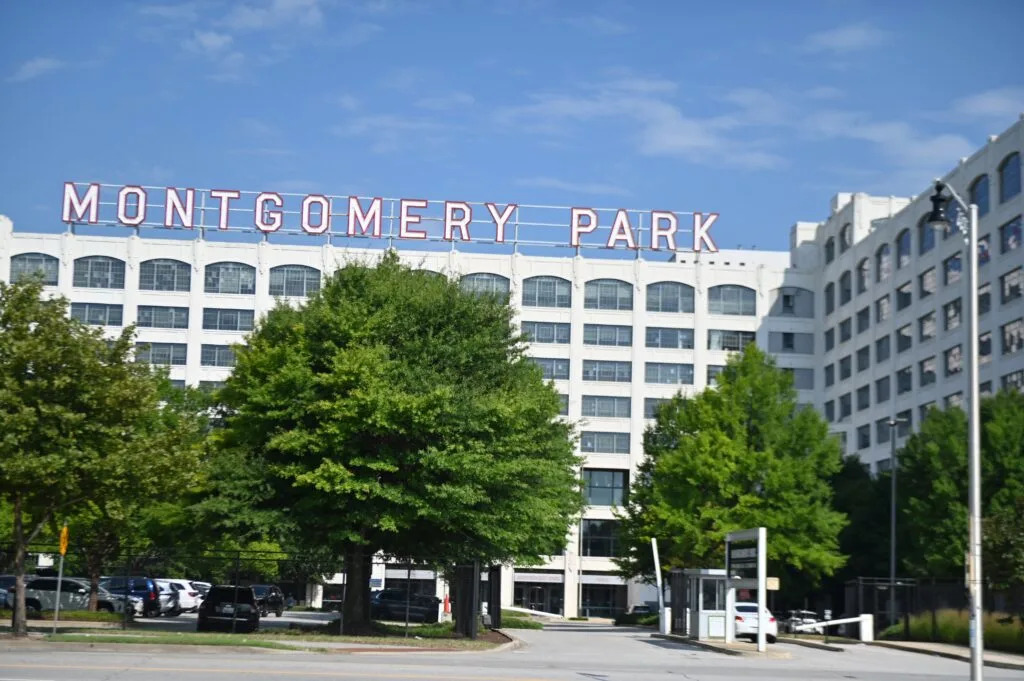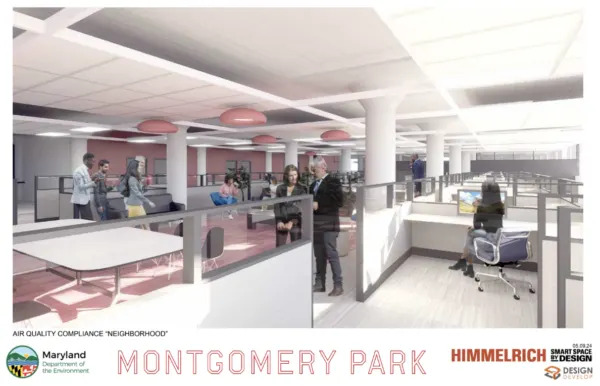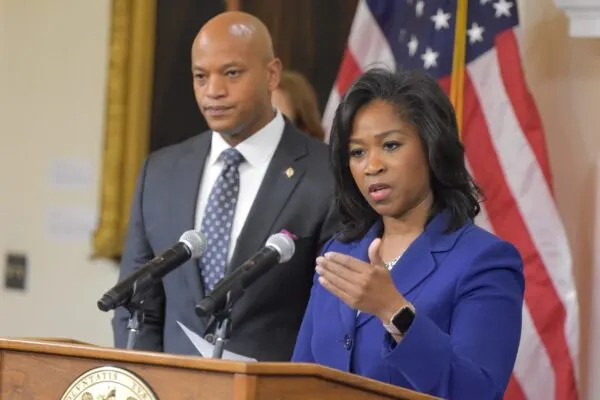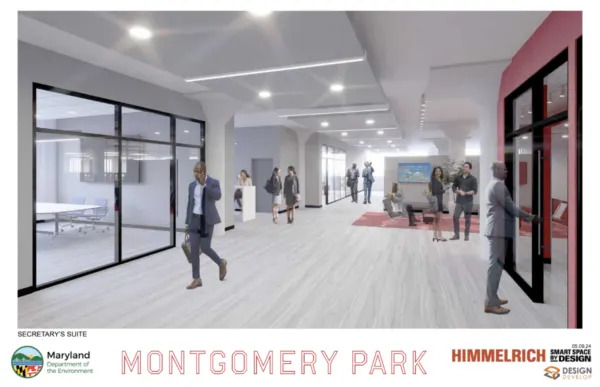
A lease agreement between the state and owners of the Montgomery Park Business Center is raising eyebrows because of it's 20-year term that limits the ability of state agencies to cancel or seek a better deal later. (Photo by Bryan P. Sears/Maryland Matters).
In the months ahead, the Maryland Department of the Environment’s offices at Montgomery Park in West Baltimore will begin a transformation, from a drab maze of cubicles to an airy, modern office space.
Here’s hoping employees like it. Because the agency will be there until at least 2044.
The 20-year rental term — exceptionally long for state leases — is how the agency secured its $10 million makeover from the building’s owner, which will include fresh cubicles for employees, a new office suite for leadership and eco-friendly add-ons, like rooftop solar panels and all-electric infrastructure.
The state also has very few ways out of the $167 million deal. Absent from the agreement is a common provision in state leases, which allows the state to back out for “convenience,” or if termination is in the state’s best interest. It means the state will likely not have the ability to seek a new, potentially more competitive, lease rate for the next two decades.
The renovation plan is coming amid a state budget crunch, during which Gov. Wes Moore’s (D) administration has issued buy-out offers to state employees, and touted cost-cutting associated with state offices.
The lease is expected to be scrutinized in a forthcoming independent report being prepared for the General Assembly.

The lease, which escalates in cost 3.45% each year, is also raising some eyebrows among Annapolis observers, who question whether, through the lease, the state is essentially footing the bill for upgrades to a private building, owned by Himmelrich Associates. Local commercial real estate professionals say the deal stands out, namely for its length.
The state Department of General Services, which handles state leasing, upholds the deal, arguing that the longer term with less flexibility was a necessary sacrifice to secure updates for a space that hasn’t seen a major renovation since the agency arrived there in 2002.
“DGS was able to secure a $10 million renovation budget as a concession in exchange for the extended term,” wrote DGS spokesman Eric Solomon. “These concessions further helped the State avoid costly relocation and parking expenses, since the current location provides free parking to all MDE employees.”
Moore’s administration has generally turned away from owning office properties, arguing that they can come with costly maintenance and repair needs, unlike with leases. State officials are in the process of moving employees out of the aging State Center complex in Baltimore, a facility that the state owns that has fallen into disrepair.
The Maryland Department of the Environment deferred to DGS for comment. Himmelrich Associates did not return a request for comment.
Sheila McDonald, who evaluated state contracts for 25 years as executive secretary for the Maryland Board of Public Works, said she found the lease unusual, particularly for its timeline.
“It certainly is rare,” said McDonald, now an attorney with O’Malley, Miles, Nylen & Gilmore. “It certainly is something that the board should consider very carefully when they were approving it, because it is a long time for the state to be bound.”
The renovation plan also caught her attention because of its large budget — and the fact that the landlord will seemingly decide who completes the work, skirting the state’s typical procurement procedures.
“This private company is using the public money and fixing up a private building — and not following any of the public laws about how to select and how to spend that money,” McDonald said.
Montgomery Park is a converted warehouse space that also houses other state agencies, including the Maryland Energy Administration and the Maryland Lottery and Gaming Control Agency. The state Department of the Environment, which has more than 900 employees, occupies more than 260,000 square feet in the building, taking up several floors.
It isn’t the first time the building, located beside Carroll Park in an industrial area off Interstate 95, has made headlines for a deal with the state. During Gov. Larry Hogan’s (R) administration, the state initially planned to move the Maryland Insurance Administration to Montgomery Park, but backed out of the deal and opted to stay at an office in downtown Baltimore. Montgomery Park appealed to the Maryland State Board of Contract Appeals, and won a favorable decision in 2020, though the agency remains downtown.

When the Board of Public Works, which includes Moore, Comptroller Brooke Lierman and Treasurer Dereck Davis (all Democrats), approved the latest Department of the Environment lease in January 2024, several members praised the deal, focusing on the green upgrades to the building, rather than the aesthetic changes to the building’s interior. It passed unanimously.
Lierman applauded the agency and the Department of General Services for “working together to not only renew their lease, which is excellent, but to really provide an example of how we can advance the goals of the Maryland Climate Solutions Now Act by transitioning that building and those offices by requiring installation of solar.”
Maryland Secretary of the Environment Serena McIlwain took a similar tack, upholding the lease as an opportunity for her department to “stand up and be the leader and make sure that we are providing the example for other buildings,” citing the 66 kilowatt solar array and electric upgrades.
Moore applauded both McIlwain and building owner Sam Himmelrich, adding: “This is extraordinary work.”
Two weeks later, the Board also approved a mirror-image, 20-year lease for the far smaller Maryland Energy Administration, which is also at Montgomery Park, and will be relocated to a renovated office space in the building, in tandem with the Department of the Environment renovation. State officials say the Energy Administration’s renovation will happen first, and could be finished by the end of this year.
Energy Administration Director Paul Pinsky said in an interview that the renovation will allow the roughly 65-person agency to share one floor in Montgomery Park, whereas it’s currently split between two floors. The new space also offers more conference room areas for employees to gather for meetings, Pinsky said.
“MDE — it is my understanding — wanted to have all of the seventh floor, and we wanted to bring our people all together,” Pinsky said.
Asked about the 20-year term, Pinsky noted that Montgomery Park is not perfect, adding that it is an old building. But the renovation arrangement appears to be a win-win for the two state agency tenants, he said.
“From our viewpoint, it’s a practical move, and DGS agreed with that,” Pinsky said.
State officials declined to provide a specific timeline for the larger renovation to the Department of the Environment’s floors in the building, though it is delayed compared to the original timeline in the lease, which called for construction on the seventh floor, which houses the office of the secretary of the environment and other employee cubicles, to be completed by the end of 2024.

The renovation will also relocate McIlwain’s office on the seventh floor, allowing for direct access from the elevators. Before, reaching her office required walking through a large area of staff cubicles.
In response to questions about the layout change, a Moore administration official defended the plans to relocate the secretary’s office.
“The layout was not efficient in certain areas, and it certainly wasn’t helpful for the secretary to perhaps bring visitors through and have such a long walk to get to her suite,” the official said.
But the renovation will also bring in more open collaboration spaces for employees, the official said.
“We just don’t want to have a sea of cubicles, per se. You want to have collaboration space for each team,” the administration official added.
Solomon wrote that the 20-year term “permits a landlord to amortize improvement costs over a longer period, which helps to ensure the State is paying a market or below-market lease rate.”
In the first year, the state is paying about $22 per square foot. By the end of the 20-year term, the rate is $42.94 per square foot.
The starting rate is an escalation compared to the Department of the Environment’s last lease, which expired in late 2022, and ended with a lease rate at about $20 per square foot.
But the state highlights that the annual percentage increase is lower than in the agency’s prior lease, which escalated 4% each year, and a state official said their research determined the market rental rate was about $26 per square foot.
The state chose to omit the “right to terminate for convenience” because it causes landlords to face more difficulty obtaining a loan, Solomon wrote.
“Since 2021, landlords have found the current lending environment more challenging to secure financing, and lenders have often declined to provide financing when a landlord has tenants with leases that contain termination for convenience clauses,” Solomon wrote. “It is important to note that all State leases still include termination provisions for default, casualty events, and for a lack of appropriation.”
Terri Harrington, managing principal at Harrington Commercial Real Estate Services in Baltimore, described the deal as a “very long term for this market,” in a statement to Maryland Matters. But she said the 3.45% escalation rate seems appropriate given market rates.
The longer lease does allow the landlord to amortize improvement costs over a longer period, and therefore keeps the rent lower, but Harrington said she would have “at least asked for a rent reset within the term at the 10-year mark.”
“If I were negotiating this lease, I would have done a 10 year initial term with a 10 year renewal option so I could negotiate a lower rent, so it did not keep escalating over 20 years,” Harrington wrote.
In all likelihood, McDonald said the two agencies probably signed the deal for its expediency. On the one hand, the Department of the Environment and the Energy Administration got what they wanted — a refreshed office space — and on the other, the Department of General Services got a lease that wouldn’t have to be renegotiated for decades.
“It is the easier way than having to renew the lease every five years, and possibly having to go out on a procurement,” McDonald said.




Comments